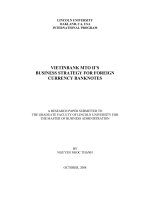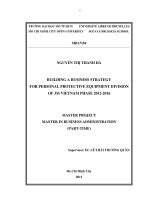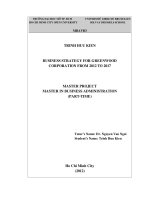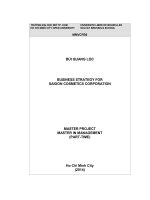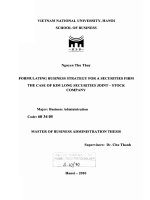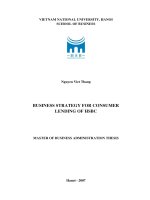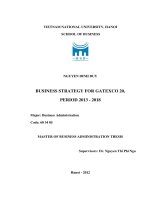Business strategy for greenwood corporationfrom 2012 to 2017
Bạn đang xem bản rút gọn của tài liệu. Xem và tải ngay bản đầy đủ của tài liệu tại đây (1.55 MB, 87 trang )
TRệễỉNG ẹAẽI HOẽC Mễ TP. HCM
UNIVERSITE LIBRE DE BRUXELLES
HO CHI MINH CITY OPEN UNIVERSITY SOLVAY BRUSSELS SCHOOL
MBAVB3
TRINH HUU KIEN
BUSINESS STRATEGY FOR GREENWOOD
CORPORATION FROM 2012 TO 2017
MASTER PROJECT
MASTER IN BUSINESS ADMINISTRATION
(PART-TIME)
Tutors Name: Dr. Nguyen Van Ngai
Students Name: Trinh Huu Kien
Ho Chi Minh City
(2012)
i
WARNINGS
“The Joint Master Program between Ho Chi Minh City Open University and Solvay
Brussels School is not responsible for any arguments, data, or statements contained
in this thesis. These are only binding upon the author”
ii
ACKNOWLEDGMENT
I would like to express my deep gratitude to many people that have given me
support, assistance and guidance to complete this project. The undertaking of this
project may not be possible without the following people.
First and foremost, I would like to thank my advisor on this thesis, Dr. Nguyen Van
Ngai for his valuable guidance and useful advices for the project.
I am thankful to the top managers and the staff of all the functional departments of
Greenwood Corporation for their support during the time of data collection for this
study.
Thanks are also due to The Joint Master Program between Ho Chi Minh City Open
University and Solvay Brussels School for providing me opportunity to pursue
master degree in this MBA course.
Finally, on a more personal note, I would like to thank my wife and my parents for
their deep love and persistent support.
iii
ABSTRACT
Greenwood Corporation is operating in Medium Density Fiberboard (MDF) Industry
which has been developing rapidly in recent years due to the strong growth of the
wood processing and construction sector. Greenwood is now facing fierce
competition from existing rivalries and many new entrances. So, building a business
strategy is Greenwood’s utmost issue. This research aims to develop a business
strategy for Greenwood in order to compete with many of competitors then to
achieve its missions, vision & goals.
The research starts by reviewing the theories relating to business strategy. Then, a
framework of the research is designed to follow. The study continues with the
analysis of the internal and external environment to find out its opportunities,
threats, strengths and weaknesses.
The external analysis consists of macro environment, industry and customer
analysis.
Macro environment factors are analyzed through PEST analysis theory. Porter’s
Five-force Model is used to carry out industry analysis to indicate the company’s
opportunities and threats. To make the external analysis more realistic, an individual
in-depth interview is firstly conducted to know expert’s ideas about the Five-Forces
affecting firms in MDF industry.
In the internal analysis, the Michael E. Porters’ value chain theory is used to analyze
company’s value activities to identify its strengths and weaknesses that enable its
competitive advantages. This helps to locate company’s present competitive
positions which define Greenwood's strategic capability. To make the research more
realistic, a customer survey is conducted to know customer requirements & needs,
behaviors and expectations and their perception about Greenwood’s product
compared to competitors in the markets. It is used to identify Greenwood and
competitor’s current position in the market. The result of the surveys and
information collected from in-depth interview are consolidated into the SWOT
analysis to place strategic actions for Greenwood.
iv
Finally, the research goes deeply into developing business strategy for Greenwood.
First, Greenwood’s missions, vision & goals are reviewed. SWOT Analysis &
SWOT strategy are used to place strategic actions that fit company’s resource and
capabilities to the demand of the market.
This study focuses on designing a strategic approach for Greenwood Corporation to
compete with rivalries and to develop sustainably in the MDF Industry. And this
business strategy is just the first step to help Greenwood to achieve its missions,
vision & goals. Any recommendations are highly appreciated and useful for
Greenwood to apply the business strategy successfully.
v
PROFESSOR’S COMMENTS
I confirm that student Trinh Huu Kien has fully finished the thesis “BUSINESS
STRATEGY FOR GREENWOOD CORPORATION FROM 2012 TO 2017”.
I certify that I have read this project and that, in my opinion, it is fully adequate in
scope and quality as a thesis for the degree of Master of Strategic Management.
Dr. Nguyen Van Ngai
vi
TABLE OF CONTENT
Title Page
Cover Page i
Warnings ii
Acknowledgement iii
Abstract iv
Professor’s comments .v
Table of Content .vi
List of Abbreviations ix
List of Figures .x
List of Tables .xi
CHAPTER 1 1
INTRODUCTION 1
1.1.
Rationale of the study 1
1.2.
Problem statement 2
1.3.
Research Objectives 2
1.4.
Research Methods 2
1.4.1
Research Framework 3
1.4.2
Information Need 5
1.4.3
Data collection method & research tools 5
1.4.4
Sampling 6
1.4.5
Data Processing 6
1.5
Scope and limitations of the study 6
1.6
Structure of the study 6
CHAPTER 2 8
LITERATURE REVIEW 8
2.1
Strategy & Business strategy 8
2.1.1
Strategy definition 8
2.1.2
Corporate strategy 8
2.1.3
Business strategy 9
2.1.4
Functional strategy 9
2.2
Competitive advantage 9
2.2.1
Definition 9
2.2.2
Generic building blocks of competitive advantage 10
vii
2.3
Strategy formulation process 11
2.3.1
Visions, Missions and goals 12
2.3.2
External analysis 12
2.3.3
Internal analysis 16
2.3.4
Strategy formulation and strategic choice 18
2.3.5
Strategy implementation 20
CHAPTER 3 22
SITUATION ANALYSIS 22
3.1
Company Introduction 22
3.2
PEST Analysis (External Analysis) 23
3.2.1
Political factor 23
3.2.2
Economic factors 24
3.2.3
Social, cultural factors 26
3.2.4
Technological factors 27
3.3
Industry analysis (External Analysis) 27
3.3.1
Vietnam Wood Processing Sector Overview 27
3.3.2
MDF Industry analysis 29
3.3.2.1
MDF Industry Overview 29
3.3.2.2
Domestic MDF production 31
3.3.2.3
Imported MDF 34
3.3.2.4
Supply/Demand MDF of Vietnam 35
3.3.2.5
Overview of International MDF Market 37
3.3.3
Porter's Five-Forces analysis 38
3.4
Customer analysis (External analysis) 44
3.5
Greenwood’s Value Chain Analysis (Internal analysis) 47
3.5.1
Primary Activities 47
3.5.2
Support Activities 50
CHAPTER 4 52
DEVELOPING BUSINESS STRATEGIES FOR GREENWOOD 52
4.1
Greenwood's Mission, vision and goals review 52
4.2
SWOT analysis 52
4.3
SWOT strategies 53
4.3.1
SO or BASE strategy 53
4.3.2
WT or SURVIVAL strategy 53
4.3.3
WO or EXPANSION strategy 54
4.3.4
ST or DEFENSIVE strategy 54
4.4
Greenwood’s Strategy Developing 54
4.4.1
Marketing 54
viii
4.4.2
Financial 56
4.4.3
Human Resource 56
4.4.4
Research and Development 56
4.4.5
Production and Quality Management 56
4.4.6
Integration 57
CHAPTER 5 58
CONCLUSION AND RECOMMENDATION 58
5.1
Conclusions 58
5.2
Recommendations 58
BIBLIOGRAPHY 60
APPENDICES 62
ix
LIST OF ABBREVIATIONS
MDF: Medium Density Fiberboard
BMI: Business Monitor International Ltd.
BPB: Bargaining Power of Buyer
CPI: Consumer Price Index
CRM: Customer Relationship Management
FDI: Foreign Direct Investment
GDP: Gross Domestic Product
GSO: General Statistics Office of Vietnam
CPV: Communist Party of Vietnam
ISO: International Organization for Standardization
KPI: Key Performance Indicator
PEST analysis: Political, Economic, Social, and Technological analysis
SWOT analysis: Strengths, Weaknesses, Opportunities and Threats analysis
WTO: World Trade Organization
UNCTAD: United Nations Conference on Trade and Development.
UN: United Nations.
x
LIST OF FIGURES
Figure 1: Framework of the research 4
Figure 2: Value to customer and producer 10
Figure 3: PEST & Porter’s Five-force Model 13
Figure 4: The Five Competitive Forces that Determine Industry Profitability 15
Figure 5: Generic Value Chain 17
Figure 6: SWOT strategy 19
Figure 7: Greenwood’s Organizational Structure 22
Figure 8: Greenwood’s Business Results 2010-2011 23
Figure 9: Vietnam GDP growth (2001-2011) 25
Figure 10: Vietnam wood processing sector export turnover (2001-2011) 28
Figure 11: MDF Industry value chain 29
Figure 12: Cost Component- MDF 31
Figure 13: Capacity of MDF Manufacturers in Vietnam 2012 33
Figure 14: The import volume of MDF of Vietnam from 2001-2011 35
Figure 15: Domestic MDF Demand/Suply from 2011 to 2017 (estimate) 36
Figure 16: MDF Price from 2002-2010 (Far East) 38
Figure 17: Summary of Porter’s Five Force Analysis 39
Figure 18: Key important factors of customers when choosing MDF supplier 45
Figure 19: Most concerned factor relating quality of MDF product 45
Figure 20: MDF Quality and Delivery Service Assessment 46
xi
LIST OF TABLES
Table 1: Generic competitive strategy and required competencies 19
Table 2: List of MDF factories operating in 2012 32
Table 3: List of MDF factories operating in 2014 (forecast) 33
Table 4: Vietnam MDF production/demand estimation from 2012-2017 36
Table 5: MDF Capacity by regions/Country in 2009 37
Table 6: Biggest MDF Manufacturers in South East Asia 38
Table 7: Summary of Greenwood’s strategic factors 52
1
CHAPTER 1
INTRODUCTION
1.1. Rationale of the study
Vietnam Wood processing Sector has strongly developed for the last 10 years. Wood
processing enterprises are working in the fields of interior and exterior furniture or
wooden handicraft to serve the domestic market and for export. There are about
2.562 wood processing enterprises in all over the country, which are creating jobs
for nearly 170,000 employees. Vietnam wood products have been on the market of
120 countries through more than 1,000 direct and indirect exporters. The turnover of
wood-products exports grows by 30-35% in recent years, from US$219 million in
2000 to US$3.9 billion in 2011. The target for 2020 is US$7 billion, which can be
achieved if the timber industry continues to grow by 35% per year. Products of
Wood processing Sector become one of the top 5 export commodities after textile,
crude oil, footwear and seafood. Vietnam has surpassed Indonesia and Thailand to
become one of the leading furniture exporters in Southeast Asia.
The development of Wood processing Sector has been accompanied with an increase
in demand for raw wood materials, including natural wood and engineered wood
such as Medium Density Fiberboard (MDF) and Particle Board (PB). Vietnam had
imported about 200,000 m3 of MDF in 2007 and 450.000M3 in 2011. Whereas in
2011, there were six local MDF manufacturers with a total capacity of 250,000 M3
MDF, only meet 35% of domestic demand.
From the beginning of production in 2008 to 2011, MDF product of Greenwood sold
easily due to good quality of MDF, effective distribution system but the most
important reason is that the domestic supply of high quality MDF is not enough to
meet the demand.
However, in last 2-3 years, there are more MDF manufacturers launched. Especially
in one year 2012, there are 5 new large MDF manufacturers launched with total
capacity of 614,000 M3. This raise the total domestic MDF capacity up to 864,000
M3, exceed more than 150,000 M3 with the total demand of 2011. Among them,
2
there is a very big manufacturer with capacity of 300.000M3 per year, five times
more than the capacity of Greenwood. In addition, some more MDF plant will be put
into production in the next 2-3 years. This will be a huge challenge and pressure for
Greenwood in context of fierce competition with domestic and imported MDF.
Start from the above findings, the making of development and competition strategy
for Greenwood is the vital task for the company. This strategy will help the company
determine the direction and steps in the next five years from 2012 to 2017 for
existing and sustainable development. This project is to develop business strategies
for Greenwood from 2012 to 2017.
1.2. Problem statement
From 2012 onwards there is a fierce competition among domestic MDF
manufacturers to grab the market. Domestic supply exceeds demand, while imports
from foreign sources continue to flow in. Greenwood has lost many customers to
competitors, while the decrease of MDF price influents to the profitability of the
company. The company is very confused to determine what has to do to compete
with the competitors in order to survive and sustainably develop. In present, the
company does not have a long-term strategy which is needed to orient the company's
activities for competition and sustainable development.
1.3. Research Objectives
The objective of the research is to analyze overall the current market and condition
for MDF industry in Viet Nam.
It is also to analyze Greenwood’s business performance in this industry.
Finally, the research aims to develop a business strategy for Greenwood in order to
compete with competitors, and become one of the leading companies in the MDF
industry in Vietnam.
1.4. Research Methods
This is an applied research. Qualitative & quantitative research methods are
combined to conduct the research.
3
Data and information needed for conducting the research were obtained basically by
the desk research and qualitative research method. In addition, some data is collected
by the quantitative research method.
The qualitative research used here is individual in-depth interview method. In the
quantitative research, a survey method is used to collect data by questionnaire.
1.4.1 Research Framework
4
Figure 1: Framework of the research
The analysis of current performance of industry and company is based on the
process of strategic management, which is used to implement SWOT analysis for the
company. First, company visions, missions and goals are examined. Then external
and internal environments are analyzed to identify strategic situation that company is
External Analysis
PEST
Porter’s Five-Forces
Expert Interview
Customer Survey
SWOT ANALYSIS
PLACING STRATEGIC ACTIONS AND
SELECTION OF THE STRATEGY
Internal Analysis
Porter's Value Chain
Customer Survey
SITUATION ANALYSIS
IDENTIFYING PROBLEM
Literature review
Strategy
formulation
process
Opportunities and
Threats
Strengths and
Weaknesses
VISION, MISSION & GOALS
CONCLUSIONS AND RECOMMENDATIONS
5
facing. Strategies are developed for the company and evaluated to choose the most
suitable one for recommendation. Figure 6 illustrates the framework of the research.
1.4.2 Information Need
The research has to clarify the following information, which is useful to analyze.
- Expert’s ideas about the MDF Industry including Five-Forces (Threat of new
entrants, threat of substitute, bargaining power of buyer, bargaining power of
supplier, Rivalry in existing firms) in the Industry.
- Customer requirements & needs for the MDF product.
- Customer perception about Greenwood’s MDF product compared to competitors in
the markets.
- Customers’ behaviors and expectations;
1.4.3 Data collection method & research tools
Secondary data on PEST factors, Wood Processing Sector, MDF Industry,
Greenwood’s existing competitors & customers is gathered from business and
industry journals, internet and other sources via desk research method. Information
about company’s business and operation is gathered from Greenwood’s Financial
Statement Reports, Greenwood’s brochure & website, other relevant documents.
This data & information gives board view about external macro-environment &
micro-environment factors affecting Greenwood’s business. This information is for
analyzing the micro-environments that affect Greenwood’s operation.
Primary data is collected via qualitative research method through individual in-depth
interview with experts, existing customers’ leaders & managers in Wood Processing
Sector (questions for in-depth interviews are shown in appendix 4). The purpose of
primary data collecting is to get expert’s ideas about company’s forces affect in this
Industry.
Primary data is also collected via quantitative research method through a customer
survey to identify customer requirements & needs, behaviors and expectations for
the MDF product. The survey is also to know customer perception about
Greenwood’s MDF product compared to competitors on the markets. It is used to
6
identify Greenwood and competitor’s current position in the market (Questionnaires
shown in appendix 7).
The data collected is consolidated in the company a whole scenario, which will be
used to suggest alternatives and action plans for the company.
1.4.4 Sampling
- Individual in-depth interview: 15 persons interviewed in 1-2 hours/person. They
are existing customers’ CEOs, managers.
- Customer survey: The questionnaire was distributed to 60 existing customer’s
managers (CEO and the managers). They represent more than 50% of Greenwood’s
total existing customers.
1.4.5 Data Processing
Data is processed primary by simple calculation via excel program.
1.5 Scope and limitations of the study
This study researches Greenwood business activities from the start of operation. It
focuses on domestic MDF market and imported MDF sources, but not studies deeply
about the international MDF market.
1.6 Structure of the study
Chapter 1. Introduction
This chapter provides an introduction including the rationale of the research,
problem statement, the objectives, the methodology of research, the scope and
limitations as well as the structure of the study.
Chapter 2. Literature Review
This chapter shows the literature review of the topic being considered. This will
encompass the fundamental ideas on strategy, business strategy, competitive
advantage and competitive strategy, strategic management, strategy formulation
process including models for external analysis (PEST & Porter’s Five Force Model)
and internal analysis (Potter’s Value chain theory), strategy formulation & strategic
choice and strategy implementation. All are reviewed as the basis for analysis in
following chapters.
7
Chapter 3. Situation Analysis
This chapter analyzes both the internal and external environments of the company in
order to understand the firm’s own capabilities, customers and business
environment.
The external analysis consists PEST analysis, industry analysis and customer
analysis. Environment factors including political, economic, social conditions and
technological factors are analyzed through PEST analysis theory. Porter’s Five-force
Model is used to carry out industry analysis in this section as well. This help to
indicate the company’s opportunities and threats.
The internal analysis deals with analyzing company’s value activities that enable
company’s competitive advantages. The Michael E. Porters’ value chain theory is
used to analyze the value activities including company’s primary & support
activities. This help to examine a firm’s competitive advantages. Firm’s
infrastructure, human resource management, marketing & sales, service activities are
analyzed to identify company’s strength and weakness in order to locate its present
competitive position. Its ultimate goal is to determine the critical success factors
which define Greenwood's strategic capability.
Chapter 4. Research Results & Findings (Developing business strategy for
Greenwood).
This chapter is devoted to the expected outcome of the study to develop the strategic
actions based on the analysis from previous parts. Greenwood’s mission, vision &
goals are reviewed. SWOT Analysis & SWOT strategy are used to place strategic
actions that fit company’s resource and capabilities to the demand of the market in
which the company operates. Finally, an overall business strategy and action are
chosen to implement.
Chapter 5. Conclusion and Recommendation
This chapter encompasses the conclusions and practical recommendations on the
implementation of the selected business strategy for Greenwood Corporation.
8
CHAPTER 2
LITERATURE REVIEW
2.1 Strategy & Business strategy
2.1.1
Strategy definition
According to the Traditional Approach there are some definitions of strategy.
- Harvard's Alfred Chandler (1962) defined strategy as "the determination of the
basic long term goals and objectives of an enterprise , and the adoption of courses
of action and the allocation of resources necessary for carrying out these goals".
- James B. Quinn of Dartmouth College (1980) defined strategy as "the pattern or
plan that integrates an organization's major goals, policies, and action sequences
into a cohesive whole".
According to New Approach, Mintzberg (1987) defined strategy as "plan, ploy,
pattern, position, perspective." As plan, strategy deals how leaders establish
direction for organization, to set predetermined of action. As ploy, strategy takes us
into the real of direct competition, where threats and trick and various schemes are
employed to gain advantage. As pattern, strategy focuses on action. As position,
strategy encourages us to look at organizations in their competitive environment,
avoid it or destroy it. As perspective, strategy referred as strategic intent.
Any firm can consider three level of strategy: corporate strategy, business or
competitive strategy, and functional strategy.
2.1.2 Corporate strategy
Corporate strategy is primarily about the strategic choice of direction for the
company as a whole. It raises three key issues facing the corporation: (1) the firm’s
overall strategy toward growth, stability or retrenchment (directional strategy); (2)
The industries or market in which the firm competes through its products and
business unit (portfolio strategy); and (3) The manner in which management
coordinates activities and transfer resource and cultivate capabilities among product
lines and business units.
9
2.1.3 Business strategy
Business strategy refers to the plan of actions that management adopts to use a
company’s resource and its distinctive ability to gain a competitive advantage over
its rivals in a market or industry. Michael E. Porter (1985) said:
“Competitive strategy is the search for favorable competitive position in an
industry, the fundamental arena in which competition occurs. Competitive strategy
aims to establish a profitable and sustainable position against the forces that
determine industry competition”.
He proposed three generic strategies company can pursuit to outperform its
competitors in the market:
- Cost leadership strategy: strategy to design, produce and market a comparable
product more efficiently and thus cheaper than its competitors do. Cost leadership
strategy aims at the mass market. Low cost structure allows company to charge
lower price and thus allow company to compete when fierce competition exist with a
quite reasonable good profit.
- Differentiation strategy refers to strategy to deliver uniqueness and superior value
to buyers in terms of product quality, special feature, or after sales services. Unique
product enables firms to charge higher price for its product. Differentiation is viable
for above-average profit.
- Focus strategy: focus strategy can be cost focus or differentiation focus. This
strategy focuses to serve only specific needs of a market segment.
2.1.4 Functional strategy
Of the three levels, functional strategy is the lowest level and it is clearly must
comply with business strategy. Functional strategy is taken by a functional area to
archive corporate and business objective and strategy by maximizing resource
utilization.
2.2 Competitive advantage
2.2.1 Definition
10
In the Book Competitive Advantage, Michael E. Porter (1985) said: “Competitive
advantage is at heart of a firm’s performance in competitive markets”:
“Competitive advantage grows fundamentally out of the value a firm is able to
create for it buyers. It may take the form of prices lower than competitors’ for
equivalent benefits or the provision of unique benefits that more than offset a
premium price”. “Today, the importance of competitive advantage could hardly be
greater. Firms throughout the world face slower growth as well as domestic and
global competitors that are no longer acting as if the expanding pie were big enough
for all”
The heart of competitive advantage lies in the concept of value creation. The
value of a product to a consumer may be V, the price that company can charge under
competitive pressure may be P, and the cost of producing that product is C. the
company profit is equal to P-C while the consumer benefit equal to V-P. For two
similar products with the same price P1=P2, product 1 has competitive advantage if
V1>V2.
Figure 2: Value to customer and producer
(Source: Hill and Jones, 1998)
2.2.2 Generic building blocks of competitive advantage
11
Many factors contribute to competitive advantage of a company. But in general, they
can be classified into four generic categories:
- Efficiency: is the ratio between a company’s output to its input. The more efficient
the company, the more outputs it can produce from certain units of input or in other
words, it can produce the same amount of outputs from less inputs thus efficiency
helping company to achieve low cost competitive advantage.
- Quality: high quality of a product or service has strong contribution to company’s
competitive advantage. First, high product quality give positive perception of
customer about product, increase customer preference thus company can charge
higher price for higher quality. Second, high quality comes from greater efficiency
and lower defective rate. Low defective rate requires less time to fix substandard
product and reduce the labor cost for fixing it. These two effects combined bring
company higher profit rate.
- Innovation: innovation can be defined as new way company produce product or
product it’s self. Innovation can be in the form of process, product design,
management system, organization structure or even in the business practice of the
company. Innovation can be the most important component of competitive
advantage. It is the single most important to the differentiation of product or process
that the competitors do not have. Uniqueness can allow company to charge higher
price for its products.
- Customer responsiveness: to be viable, any company must find their customer and
satisfy their needs. The process of adjusting, tailoring product features to market will
be crucial to company competitiveness. Another aspect of customer responsiveness
is customer respond-time, which is the time require company to bring a product to
customer hand.
2.3 Strategy formulation process
Strategy formulation process refers to the process by which managers choose a set of
strategies for an enterprise. This process can be broken down into five major steps:
(1)- Selection enterprise’s vision, mission and goals;
12
(2)- External environment analysis to identify company’s opportunities and threats;
(3)- Internal analysis to identify company’s strengths and weaknesses;
(4)-Strategy formulation & strategic action choice;
(5)-Strategy implementation.
2.3.1 Visions, Missions and goals
The beginning point of strategic management process is to review and/or selecting
new organization’s vision, mission and major goals. This statement will be the
foundation for strategy formulation and implementation in later steps.
Vision is a guiding idea that answer the question” “What is the organization’s raison
d’être?” and serves as a permanent guideline for all employees. A vision says
something that clarifies the direction in which an enterprise needs to move: What we
stand for and why we exist; therefore leading to the mission.
The mission sets out the reason why the organization exist, what it aspire to
become, to achieve, to create; whose benefit it serve and what it should do. For
example, the mission of an airline is to provide convenience and safety flight to its
customers.
Major goals are the targets that an organization wants to fulfill in long or medium
term. Most profit-seeking organizations place maximization of profit near the top of
their goals. Other possible goals are to get the largest share in the market that a
company currently competes in two years for example, or to get annual sale growth
of 17% etc. Goals should be specific and measurable within a time frame.
2.3.2 External analysis
External analysis focuses on examination of relevant external elements to company.
The objective of this analysis is to identify company’s present and potential threats
and opportunities. PEST analysis theory and Porter’s Five-force Model are
combined to carry out environment factors and industry analysis including
competitor and customer analysis.
13
Figure 3: PEST & Porter’s Five-force Model
(Source: Michael E. Porter)
An opportunity is a trend or event that could lead to significant upward change in
sales and profit pattern-given appropriate response. A threat is a trend or event that
will result in the absence of strategic move, in a significant reduction in sales and
profit figures. External analysis including the following analysis:
2.3.2.1 PEST analysis
The PEST Analysis or model is a tool specialized and focused to scan of external
macro-environment that can affect present and future business. The PEST acronym
stands for: Political, Economic, Social &Technological. These factors have not only
a short-run impact in firm'’ performance but also an influence firm's long run
decision.
- Political factors include government type and stability, legal system, administrative
procedures, rule of law, bureaucracy, corruption, regulation, social/employment
legislation, government’s policies to support a certain industry, and likely political
change.
- Economic factors consist of business cycle GDP growth, inflation, trade deficit,
interest rates, economic policies, unemployment, labour supply, labour cost,
globalization and likely economic change.
